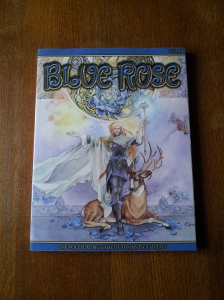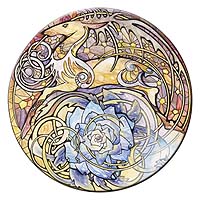 The RPG of today is ‘First RPG purchased’. For me, this was Blue Rose, the setting that originally codified the True20 system long before it was brought out as a generic system. It is a beautiful, if slightly silly, romantic fantasy RPG.
The RPG of today is ‘First RPG purchased’. For me, this was Blue Rose, the setting that originally codified the True20 system long before it was brought out as a generic system. It is a beautiful, if slightly silly, romantic fantasy RPG.
The definition of this is actually something I’d like to go into. There’s an assumption that ‘fantasy’ is a single thing, a genre that acts an adequate descriptor, but for as long as it’s existed, fantasy has had vastly different sub-genres and styles that constantly redefine and expand the genre. It continues to be a growing medium, even though for many years it was almost entirely characterised in popular perception by the same concepts.
We’re living in a post-Game of Thrones world, but before Game of Thrones was adapted for TV, fantasy brought a very limited palette to mind: muscle-bound heroes, sometimes knights or barbarians or humble blacksmiths, a faux-medieval setting, dragons and longswords, a quest to save the world from shadowy villains with questionable motivations. It was often assumed that all fantasy was a rip-off of Tolkien, despite the fact that Lord of the Rings is actually a lot less like the ‘standard’ fantasy formula than one might suppose. Sure, plenty of Tolkien’s elements that have become clichés (and I definitely won’t deny that there are an awful lot of LOTR clones out there), but a lot of other recognisable traits in the fantasy genre stem from the sword and sorcery stories in pulp magazines (Conan the Barbarian and Fafhrd and the Grey Mouser being some of the most famous) or the heroic fantasy stories that drew on chivalric romance traditions (as translated through Victorian literature and art). These are sometimes grouped as ‘high’ fantasy, though that definition is slippery.
Trying to define genres and subgenres always runs into arguments that literary scholars have wrestled with for a long time, but broadly speaking there are a number of dominant subgenres of fantasy. I know this is all pretty obvious to fantasy fans, so I apologise for seeming condescending, but the lesson I’d like to draw from this is that even when running Dungeons and Dragons, the archetypal fantasy game, it is worth setting out the kind of fantasy you are drawing on. Classic D&D, with dungeon crawls and wandering monsters, is usually the base line (generally a bit of epic fantasy, heroic fantasy and sword and sorcery mixed together) but even with something like the Eberron or Planescape settings, the standard template doesn’t seem to fit quite as neatly any more, let alone when you get to Ravenloft. Eberron is closer to swashbuckling fantasy in some ways, and Planescape pre-figured some of the tropes of gritty urban fantasy that are so popular today. Then you have games like Blue Rose. Blue Rose is a romantic fantasy game, not in the sense of Mills and Boon but in the sense that it puts a lot more stock in personal relationships and emotional journeys than the large-scale ‘save the world’ tensions of epic fantasy or sword and sorcery. They were also less bound by gender conventions and stereotypes, with a wider range of models for gender and sexuality in characters. See: Robin Hobb, Ellen Kushner, Mercedes Lackey, and also the really good essay at the start of Blue Rose called ‘What Is Romantic Fantasy?’
I’m not saying that you should pigeonhole your game into a subgenre, or angst over whether it’s a romantic fantasy or an epic or a sword and sorcery or a gritty fantasy. However, if someone comes to Blue Rose expecting a Conan-style sword and sorcery tale, or a po-faced LOTR epic, they’ll take one look at the opening fiction and leave. In Blue Rose, there are many elements that verge on the ridiculous because they stem from a rose-tinted world that is very much at odds with the stone-and-blood gritty fantasy of George R.R. Martin and Joe Abercrombie. In Game of Thrones, you win or you die. In Blue Rose, the new queen is chosen by a magical stag that comes out of a stained glass window because she may be humble, but she is pure of heart.
If that made you throw up a little, go elsewhere, because Blue Rose is delightful and whimsical and ridiculous. To get an idea of the mood whiplash you get from juxtaposing this with almost any other kind of fantasy, think of the bit in Snow White and the Huntsman where Snow White has escaped her grim prison and creepy jailer through determination and getting her hands bloody, and yet ends up being symbolically crowned by a magical white stag with horns covered in flowers. There was a film that didn’t know which subgenre it wanted to live in.
But that’s why I love Blue Rose for what it is. It has flying cats, and animals that talk, and an entirely unsustainable system of government. And I love D&D for what it is, and Ravenloft, and Eberron – I just make sure I know what kind of fantasy I’m going to play.
P.S. I think it was one of my friends who coined the term ‘deerocracy’ but I can’t remember which one.
P.S.S. If the bit about the magical deer made you joyful, try just looking through the Blue Rose books and tell me you aren’t charmed. They are everything you want them to be.
Links:
The Green Ronin page for Blue Rose, with downloadable adventures and much pretty
The RPG.net review for Blue Rose
An essay on ‘What Is Romantic Fantasy?’ by one of the designers, John Snead
